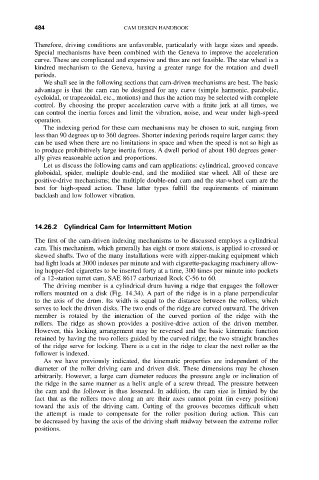Page 496 - Cam Design Handbook
P. 496
THB14 9/19/03 7:58 PM Page 484
484 CAM DESIGN HANDBOOK
Therefore, driving conditions are unfavorable, particularly with large sizes and speeds.
Special mechanisms have been combined with the Geneva to improve the acceleration
curve. These are complicated and expensive and thus are not feasible. The star wheel is a
kindred mechanism to the Geneva, having a greater range for the rotation and dwell
periods.
We shall see in the following sections that cam-driven mechanisms are best. The basic
advantage is that the cam can be designed for any curve (simple harmonic, parabolic,
cycloidal, or trapezoidal, etc., motions) and thus the action may be selected with complete
control. By choosing the proper acceleration curve with a finite jerk at all times, we
can control the inertia forces and limit the vibration, noise, and wear under high-speed
operation.
The indexing period for these cam mechanisms may be chosen to suit, ranging from
less than 90 degrees up to 360 degrees. Shorter indexing periods require larger cams: they
can be used when there are no limitations in space and when the speed is not so high as
to produce prohibitively large inertia forces. A dwell period of about 180 degrees gener-
ally gives reasonable action and proportions.
Let us discuss the following cams and cam applications: cylindrical, grooved concave
globoidal, spider, multiple double-end, and the modified star wheel. All of these are
positive-drive mechanisms; the multiple double-end cam and the star-wheel cam are the
best for high-speed action. These latter types fulfill the requirements of minimum
backlash and low follower vibration.
14.26.2 Cylindrical Cam for Intermittent Motion
The first of the cam-driven indexing mechanisms to be discussed employs a cylindrical
cam. This mechanism, which generally has eight or more stations, is applied to crossed or
skewed shafts. Two of the many installations were with zipper-making equipment which
had light loads at 3000 indexes per minute and with cigarette-packaging machinery allow-
ing hopper-fed cigarettes to be inserted forty at a time, 300 times per minute into pockets
of a 12-station turret cam, SAE 8617 carburized Rock C-56 to 60.
The driving member is a cylindrical drum having a ridge that engages the follower
rollers mounted on a disk (Fig. 14.34). A part of the ridge is in a plane perpendicular
to the axis of the drum. Its width is equal to the distance between the rollers, which
serves to lock the driven disks. The two ends of the ridge are curved outward. The driven
member is rotated by the interaction of the curved portion of the ridge with the
rollers. The ridge as shown provides a positive-drive action of the driven member.
However, this locking arrangement may be reversed and the basic kinematic function
retained by having the two rollers guided by the curved ridge; the two straight branches
of the ridge serve for locking. There is a cut in the ridge to clear the next roller as the
follower is indexed.
As we have previously indicated, the kinematic properties are independent of the
diameter of the roller driving cam and driven disk. These dimensions may be chosen
arbitrarily. However, a large cam diameter reduces the pressure angle or inclination of
the ridge in the same manner as a helix angle of a screw thread. The pressure between
the cam and the follower is thus lessened. In addition, the cam size is limited by the
fact that as the rollers move along an arc their axes cannot point (in every position)
toward the axis of the driving cam. Cutting of the grooves becomes difficult when
the attempt is made to compensate for the roller position during action. This can
be decreased by having the axis of the driving shaft midway between the extreme roller
positions.

